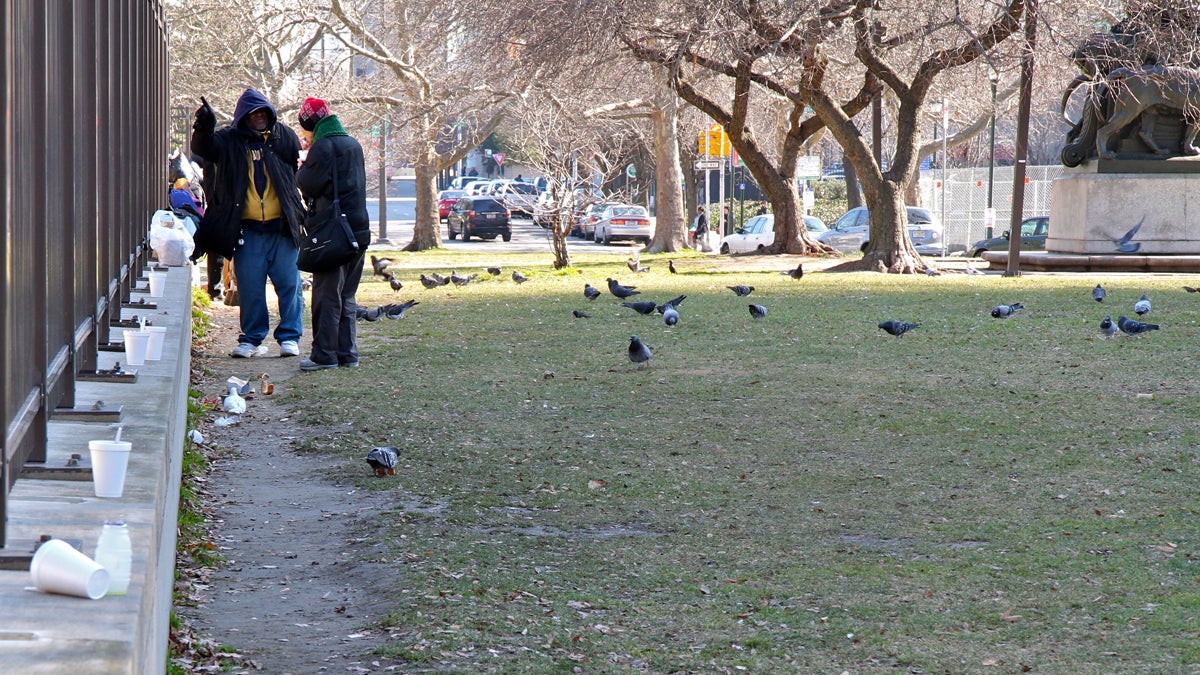Homeless, not hopeless: A view from the Free Library

A row of empty styrofoam cups remain in a park near the Free Library where servings of chili were doled out to homeless people. (Emma Lee/WHYY, file)
I have never experienced the plight of homelessness, but I’ve seen many people throughout the streets of downtown Philadelphia who have.
For the last six years, I have worked as a barista part time at the Philadelphia Free Library. I get homeless customers as well as the regular patrons of the library. Sometimes they arrive just to rest; sometimes they remain in the library all day. Nowhere else to go, I always assume.
Many can be seen daily playing with electronics or eating potato chips and sandwiches from the carts outside. There are times when these unfortunate individuals will reach into their pockets and pull out a few crumpled dollars to purchase a cup of coffee from me.
Sometimes I wonder what they must go through every day, what their interaction with people who deem them invisible must be.
Help from the outside
Usually on Mondays, from behind the register, I watch homeless people bring trays and trays of food from somewhere else into the cafe with them, not bothering anyone as they sit down to eat and talk amongst themselves. Sometimes I can overhear them. The topics they discuss can center around their day, people they encounter, or even occasional news about the Eagles.
I first learned about Adam Bruckner, one of many people who took on the task of feeding the homeless a while back when I was still attending Temple University. Mayor Nutter had proposed a ban to stop feeding the homeless outdoors, and I had interviewed Bruckner, creator of Philly Restart, to get his opinion on the matter for an assignment that I was working on for class.
Nutter, at the time, had defended the proposed ban as a much broader plan to care for the city’s poor. According to the Philadelphia Inquirer, Federal Judge William H. John Jr. released a 56-page opinion blocking Nutter’s ban.
Each Monday, Bruckner and a few volunteers set up shop across the street from the family courthouse and begin handing out trays of food to the homeless. Bruckner and his team usually raise money to purchase the food they serve.
“There is a constant need,” Bruckner said. “We have people year round. The numbers fluctuate depending on the season and the elements.”
Identity and identification
Like many of us who live in the city, Bruckner used to see homeless people all the time when attending college and often would give them a dollar, wondering why they didn’t just get a job.
He asked one day, and he was surprised to find that some of those he encountered wanted work but could not get identification that they needed to cash checks and get hired.
Bruckner’s service, Philly Restart, also assists his homeless clients in getting the necessary identification that they need.
“Since we started, there has been a dramatic increase,” Bruckner said. “But over the last few years it has stayed about the same.”
There are times when people come to me or my co-workers asking for help, services, or where they might be able to escape the cycle of homelessness.
There’s not much that we can do in this situation but listen to them and offer what advice we can.
According to the nonprofit Project HOME, each year Philadelphia homeless outreach programs work with over 5,500 individuals living on the street, in cars, in abandoned buildings, in train and bus stations, and other places.
About 12,000 people access shelter services each year, and many are turned away. The city estimates that we have an average of 650 people living on the streets on any given day, about half of whom are in Center City.
With so many in the same boat, why not pull together?
I wonder at times if the city is actually doing enough to look after the homeless. Bruckner seems to think so. He says there are a lot of people working to help with the issue, but the missing key is often collaboration.
Collaboration. What would Philadelphia be like if the nonprofits in the city whose goals are similar in preventing the cycle of homelessness set aside their difference and worked as one?
“For me, the surprising thing is the community,” Bruckner said. “I pictured the homeless as sad, lonely and broken. And there are elements of that. But they are homeless, not hopeless. It is true community where people look out for each other. It’s not perfect, but it is a little family.”
Family. I notice it all the time as I observe the homeless individuals who walk in and out of the library. They watch each other’s belongings, share what food they have with each other, and even counsel each other when things just seem unbearable.
“I don’t know what the balance is of ‘doing enough,'” Bruckner said. “The city is limited, because they don’t have bottomless pockets. They definitely care about the issue.”
WHYY is your source for fact-based, in-depth journalism and information. As a nonprofit organization, we rely on financial support from readers like you. Please give today.

